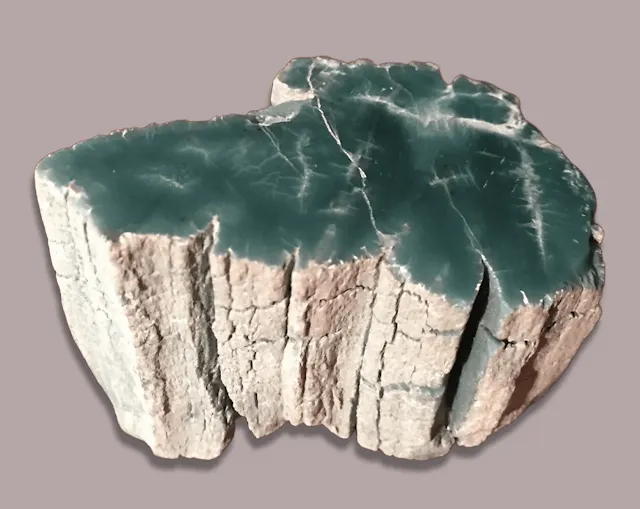Green Petrified Wood from Arizona
A rare green variety of petrified wood has been documented in a small, now-exhausted deposit of the Upper Triassic Chinle Formation near Winslow, Navajo County, Arizona. These silicified conifer logs, assigned to the extinct genus Araucarioxylon arizonicum and dated to the Norian–Carnian stages (~225 Ma), are distinguished by an emerald hue caused by trace Cr³⁺ ions incorporated into a microcrystalline silica matrix during diagenesis—unlike the more typical iron-induced reds and yellows. The material shows excellent anatomical preservation and may exhibit reversible surface darkening under high humidity due to hydration effects.
 |
| Rare green petrified wood from Arizona Photo by: LGF Foundation, Inc. |
Reference Data
- Geological Unit: Chinle Formation
- Age: Norian stage, Late Triassic (~225 Ma)
- Location: Near Winslow, Navajo County, Arizona, USA
- Fossil Wood Taxon: Araucarioxylon arizonicum (form genus; extinct conifer)
- Mineralogy: Chalcedony (microcrystalline quartz) with Cr³⁺ substitution
- Coloration Agent: Trivalent chromium ions incorporated into silica matrix
- Preservation: High-fidelity cellular detail preserved via chalcedonic permineralization
- Humidity Response: Reversible darkening in high relative humidity due to changes in surface light scattering
- Deposit Status: Depleted; specimens available only from legacy collections
Geological and Stratigraphic Context
The green petrified wood specimens originate from the Chinle Formation, a Late Triassic (~225 Ma; Carnian–Norian stages) sedimentary unit extensively exposed across the southwestern United States. The formation consists predominantly of fluvial sandstones, mudstones, and volcaniclastic deposits, reflecting an alluvial to fluvio-lacustrine depositional environment that supported abundant gymnosperm-dominated vegetation.
The chromium-bearing green wood was recovered from a small, localized lens north of Winslow, Arizona. While the Chinle Formation is widely known for its vibrantly colored silicified wood within Petrified Forest National Park, the occurrence of chromium-enriched green wood appears restricted to this now-depleted site.
 |
| Chromium-enriched green petrified wood from Arizona's Chinle Formation. Photo credit: LGF Foundation, Inc. |
Mineralogical and Geochemical Characteristics
Petrified wood forms through the process of permineralization, wherein organic plant tissues are incrementally replaced by silica-rich fluids under low-grade diagenetic conditions. In this specific occurrence, the silicification process involved significant substitution of trace elements, particularly trivalent chromium (Cr³⁺), into the lattice of cryptocrystalline quartz (chalcedony).
Electron microprobe and spectroscopic analyses conducted on comparable specimens indicate that chromium concentrations may locally exceed 1–2 wt.%, contributing to the green coloration via crystal field effects in the visible spectrum. The Cr³⁺ ion replaces Si⁴⁺ in the silica matrix under oxidizing conditions, resulting in green spectral absorption bands similar to those observed in chromium-rich minerals such as emerald (beryl) and uvarovite garnet.
Additional accessory mineral phases such as hematite, goethite, and manganese oxides are often responsible for red, yellow, or black coloration in petrified wood. However, in this occurrence, these components are either absent or present in trace amounts, allowing the chromium-induced green hue to dominate.
 |
| Green petrified wood from Arizona colored by trace chromium. |
Botanical Affinity
The original wood is taxonomically assigned to Araucarioxylon arizonicum, an extinct coniferous gymnosperm widely distributed in the Triassic deposits of North America. This species exhibited substantial secondary xylem development and growth rings, indicative of pronounced seasonality. Anatomical features such as tracheid pitting, cross-field pitting, and resin canals are well preserved, enabling detailed paleobotanical analysis.
Petrification has preserved cellular microstructure with minimal distortion, and the replacement by silica occurred in such a manner that microscopic detail is retained in high fidelity.
Optical Response to Ambient Humidity
Several specimens of the green petrified wood have been observed to exhibit reversible darkening in response to increased ambient humidity. This phenomenon is likely due to the adsorption of water molecules into microfractures or onto the surface of silica particles, which modifies the light-scattering properties of the material. These optical effects are superficial and do not indicate any structural or chemical transformation of the specimen. The variability is considered to be a surface-level interaction and is not indicative of hygroscopic behavior in the conventional mineralogical sense.
 |
| Vibrant green petrified wood from Arizona. |
Rarity and Preservation
The chromium-enriched green petrified wood is regarded as a highly localized and geochemically unusual occurrence. The primary deposit was exploited in the 1970s, and no additional material of similar composition has been documented from adjacent stratigraphic units. As a result, specimens from this occurrence are considered rare and are of both scientific and collector interest.
Preservation is typically of high quality, with minimal deformation or recrystallization. The green coloration remains stable under typical curation conditions, though specimens should be stored in environments with controlled humidity to prevent surface alterations due to moisture adsorption.
Read also:
Agatized Wood: Gemstone, Value, Uses
Opalized Wood: Gemstone, Formation, Where to Find it
Rare Opalised Wood From Nevada


%20(1).webp)





